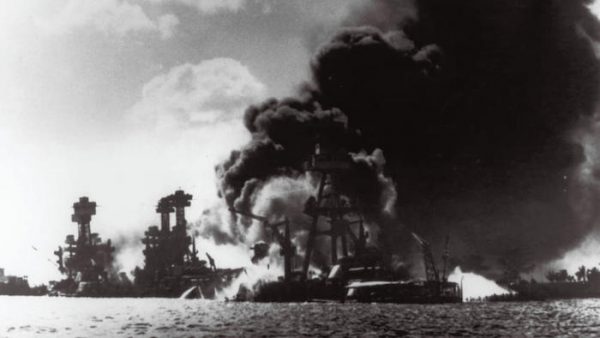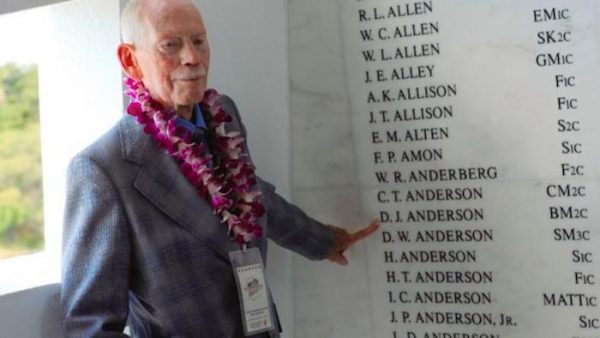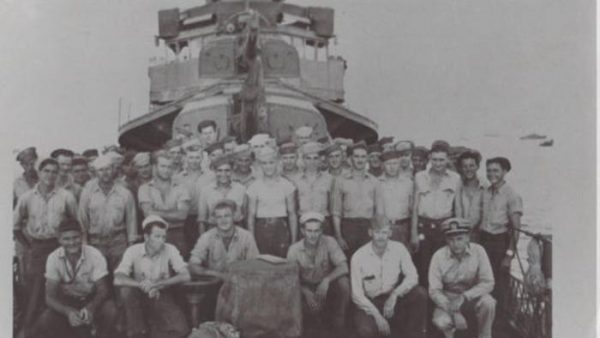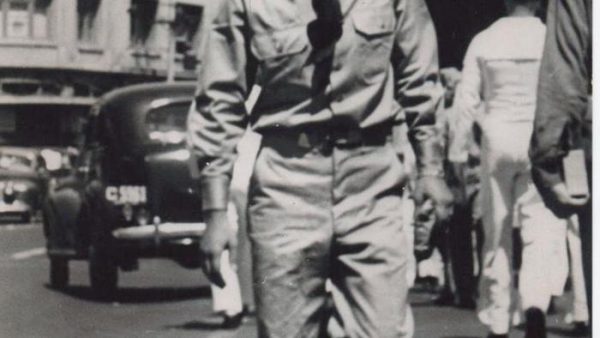[J]ohn Anderson somehow survived the bloody mayhem of the Dec. 7, 1941, Japanese attack on Pearl Harbor.
But in that attack, Anderson, a crewman on the USS Arizona, lost his twin brother, Jake.
Jake was among 1,177 sailors and Marines from the battleship who died, many of whom were entombed when the ship sank in minutes after a bomb touched off a massive explosion in one of the magazines.
Throughout an active and full life, Anderson carried the guilt of not being able to find his brother.
Now, in death, the brothers from Dilworth, Minn., will be reunited.
Anderson’s cremains, along with those of another man who survived that attack 75 years ago, will be interred by Navy divers in the No. 4 turret of the Arizona on Wednesday, Dec. 7.
Their cremains will join those of about 1,100 sailors and Marines entombed in the wreck.
“When you grow up in the shadow of a hero, you don’t always realize a hero is there,” one of his sons, Terry Anderson, 53, of Roswell, N.M., said Friday, Dec. 2. “We have a great sense of pride.”
Karolyn Anderson, 73, said that it’s been a difficult year since her husband’s death Nov. 14, 2015, at the age of 98.
“This is what John would want. I want to do that for John, and Jake. It’s very sad for me, but I’m honoring his wishes and his memory,” the Roswell woman said of her husband of 47 years.
“For years, John was hesitant to even talk about Jake, He always carried a guilt burden that he couldn’t get Jake. And finally one day, I said ‘John, you never really mention Jake, why is that?’ And he said. ‘I always felt funny that I lived and he didn’t. I always wondered why I was spared and he wasn’t.’ He just felt like he let himself down, and Jake down as well as the rest of the family.”
John and Jake Anderson were born Aug. 26, 1917, in Verona, N.D. Their family later moved to Dilworth, where the twins grew up and graduated from high school.
Both joined the Navy in March 1937.
John Anderson began his Navy career on the USS Saratoga, then transferred to a destroyer. He was in China when it was attacked by the Japanese.
“That left an impact on him. He had pictures of a Chinese refugee column machine gunned by the Japanese. Pretty graphic stuff,” Terry Anderson said.

In 1940, he was transferred to Hawaii and eventually to the Arizona.
John was a member of a crew manning one of the ship’s 14-inch turret guns, and Jake’s station was an anti-aircraft gun. John Anderson also had the duty of setting up chairs for Sunday morning worship services on the Arizona’s deck. After setting up the chairs on Dec. 7, he went below deck to have breakfast when he heard a “kaplunk,” looked out a porthole and saw planes bombing nearby Ford Island, he told columnist Bob Lind of The Forum of Fargo-Moorhead.
“They started hearing machine gun fire and explosions going off, and Dad went to the porthole of the ship out of the mess hall and that’s when he saw the Japanese planes flying by and he saw the orange balls and he knew the Japanese were there, because he had seen them in China,” said another son, John Anderson Jr., 47 of Carlsbad, N.M..
John Anderson said in accounts after the war that he then headed for his post, all the while looking for his brother, Jake. He made it to his gun turret, but before he could help load it, a bomb hit the turret’s top, bounced off and penetrated the deck. The resulting explosion killed many of the crew.
Shortly after, the forward ammunition magazine with 1.5 million pounds of gunpowder blew up, virtually splitting the Arizona, and leaving dead and dying men everywhere, he told Lind.
As the ship began sinking, a senior officer ordered Anderson onto a barge taking wounded men to Ford Island, and they picked up wounded men on the way.
Once on the island, Anderson commandeered another boat to go back to the Arizona with a shipmate, Chester Rose. On the way, they pulled survivors from the harbor, but then the small craft was hit and wrecked, and all but John perished.
“He talked about this guy Rose many many times, about how he lost his life trying to help, go back to the ship. After (many) years, he was able to locate the family and tell the family what happened to Rose,” John Jr. said.
John Anderson was wounded, but swam to land and grabbed a rifle and two bandoliers of ammunition. He then jumped into a bomb blast crater on Ford Island and told Lind that he thought, “Let ’em come!”
In a 2014 article, he told the Stars and Stripes newspaper that the next day a Marine patrol told him survivors of the Arizona were to gather on a nearby dock for a head count.
“Everybody I saw there had rags around their heads,” Anderson said. Bandages covered their arms, skin was scorched and hair was burned off. “Beat up something awful.”
Travis Anderson, 45, of Kurtistown, Hawaii, said his father passed on a very memorable lesson learned on that horrible day.
“I don’t remember what we were doing, but he said there’s a reason for rules and doing things the right way, and I kind of smarted off to him and he told me to listen,” Travis Anderson said. “He told me a story about a man locked up on the Arizona. He was in the brig and no one could find the key. Boy, that just hit me like a ton of bricks. That they were trying to get that guy out of there and they didn’t have the key. Pay attention to what you’re doing and do things right. I carried that with me the rest of my life.”
John Anderson joined the destroyer USS Macdonough, and fought in 13 major battles across the Pacific.
After his discharge in 1945, he worked as a movie stuntman and took night classes in meteorology. A friend later convinced him to join the Navy Reserves, where he served for another 23 years.
While in Hollywood, he met and worked with John Wayne and also worked on the set of the Jimmy Stewart Christmas staple, “It’s a Wonderful Life.”
Anderson moved to Roswell, where he was “Cactus Jack,” a disc jockey playing mostly country music. He met Elvis Presley and Eddie Arnold in that job.
Anderson later became a television meteorologist and a real estate agent.
“He went after it. He lived life to the fullest. It was like reading a Hollywood book. He really lived. I could just go on and on,” Travis Anderson said.
“He was a wonderful man, very charismatic. He was bigger than life,” Karolyn added.
The interment ceremony on the Arizona is unique in that it is the only ship in the U.S. Navy where the cremated remains of a survivor are returned.
“It will be a chance to say goodbye to dad and a chance to reflect on Dec. 7. A day we should never forget,” John Jr. said. “It will be a time … to thank God for all he did.”
Complete Article HERE!



